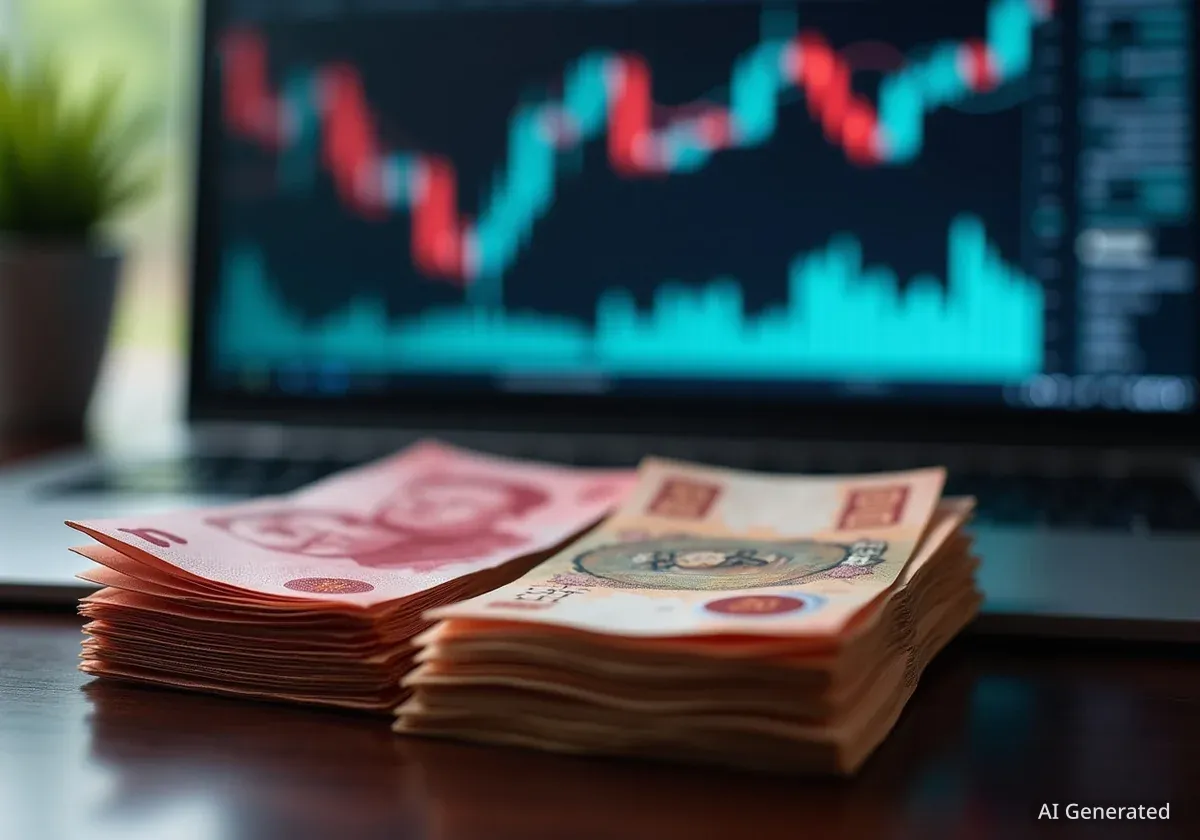Kenya has restructured US$5 billion in loans from China, converting the debt from U.S. dollars to Chinese yuan. The move is expected to provide significant financial relief, cutting the country's annual debt servicing costs by an estimated US$215 million.
Announced by Kenyan Treasury Minister John Mbadi, this currency swap addresses immediate debt pressures and aligns with China's broader strategy to increase the international use of its currency. The decision could set a precedent for other African nations facing similar debt challenges.
Key Takeaways
- Kenya converted US$5 billion in railway loans from U.S. dollars to Chinese yuan.
- The conversion is projected to save Kenya US$215 million in yearly debt payments.
- The original loans were for the Standard Gauge Railway (SGR) project.
- This move supports China's long-term goal of promoting the yuan as a global currency.
- Analysts believe this could encourage other debt-stressed African countries to pursue similar agreements.
Details of the Debt Restructuring
The agreement involves three loans totaling US$5 billion that Kenya secured from the Export-Import Bank of China (China Exim Bank) in 2014 and 2015. These funds were used to finance the construction of the 600-kilometer Standard Gauge Railway (SGR), a major infrastructure project connecting the port city of Mombasa to Naivasha.
According to Treasury data, approximately US$3.5 billion of this debt remained outstanding as of June 2024. Before the conversion, Kenya was spending about US$1 billion annually to service its total debt to China.
Loan at a Glance
- Original Loan Amount: US$5 billion
- Lender: Export-Import Bank of China
- Purpose: Standard Gauge Railway (SGR)
- Project Length: 600 km (Mombasa to Naivasha)
- Estimated Annual Savings: US$215 million
While Treasury Minister John Mbadi confirmed the currency swap, specific terms of the new yuan-denominated loan, such as the exact interest rate, have not been publicly disclosed. However, in previous statements, Mbadi had indicated that the deal was expected to reduce the SGR loan interest rates by half from the original 6.37% under the dollar-based agreement.
In addition to the currency conversion, Kenya is also in discussions with China Exim Bank to extend the repayment periods for the loans. This measure is aimed at further alleviating pressure on the country's foreign currency reserves. Plans to issue yuan-denominated panda bonds have been put on hold, with Mbadi citing that “the rates are not favourable” at present.
A Strategic Move for Both Nations
Analysts view the deal as mutually beneficial. For Kenya, it provides immediate and substantial relief from high debt-servicing costs, which are amplified by the strength of the U.S. dollar and rising U.S. interest rates.
Aly-Khan Satchu, a geoeconomic analyst focusing on sub-Saharan Africa, noted that converting the loan into yuan makes “optimal sense from a balance sheet management perspective” due to the significantly lower interest rates associated with the Chinese currency compared to the dollar.
“This conversion fits into that strategy. Kenya’s conversion is a lodestar for other African countries to do the same.”
For China, the agreement marks a significant step in its long-term campaign to internationalize the renminbi (RMB). By encouraging borrower nations to hold and transact in yuan, Beijing aims to reduce its own reliance on the U.S. dollar-dominated global financial system and challenge its supremacy.
Yufan Huang, a pre-doctoral fellow with the China-Africa Research Initiative at Johns Hopkins University, described the deal as “a win-win-win for Kenya, China Exim and the Chinese government.” He added that “Beijing is happy to see a bit more progress on [yuan] globalisation after years of effort with limited success.”
The Broader Push for Yuan Internationalization
China has been actively promoting the use of its currency across Africa and other parts of the world. This strategy includes several key initiatives:
- Currency Swap Agreements: China has signed bilateral currency swap deals with countries like Nigeria and South Africa to facilitate trade and investment in local currencies.
- Yuan-Denominated Loans: It has issued yuan-denominated loans to institutions such as the Development Bank of Southern Africa.
- Payment Systems: China is expanding its Cross-border Interbank Payment System (CIPS), an alternative to the SWIFT messaging network. Major African banks, including the African Export-Import Bank (Afreximbank) and Standard Bank, have joined CIPS to enable direct yuan payments.
De-Dollarization and CIPS
The term "de-dollarization" refers to the global trend of reducing reliance on the U.S. dollar for international trade and finance. China's CIPS is a crucial piece of infrastructure in this effort, as it allows international payments to be cleared in yuan without passing through the U.S. financial system. This insulates transactions from U.S. sanctions and financial policy.
Ovigwe Eguegu, a policy analyst at Development Reimagined, stated that this trend is a practical necessity for Beijing. “For Beijing, the internationalisation of the RMB is a practical step to shield itself against US sanctions and SWIFT dominance,” he explained.
Implications for Africa and Future Lending
Kenya's decision is being watched closely across the continent. Many African nations hold substantial dollar-denominated debt from China and face similar economic pressures. The success of Kenya's conversion could inspire countries like Djibouti and the Republic of Congo to seek similar arrangements.
However, analysts caution that this is not a universal solution. Yufan Huang noted that for some highly indebted countries, currency swaps alone “might not be sufficient to address debt sustainability concerns.” Each nation's financial situation is unique, and comprehensive debt restructuring may still be necessary.
Potential Challenges and Considerations
While a yuan-based loan offers lower interest rates, it also introduces new variables for borrower countries. Demand for such loans may be limited because:
- Lack of Reserves: Most African central banks hold limited reserves of Chinese yuan.
- Hedging Costs: Countries may face additional costs to hedge against fluctuations in the yuan's value.
- Appreciation Risk: The risk that the yuan could strengthen against local currencies, increasing the real value of the debt over time.
Furthermore, while China is promoting the use of its currency, analysts suggest that Beijing may remain cautious about issuing large volumes of new loans following difficult debt restructuring negotiations in recent years. For Kenya, President William Ruto's administration must balance its request for debt relief with its desire to secure new financing for the next phase of the SGR, which aims to extend the railway to the Ugandan border.
Ultimately, by accepting yuan-denominated loans, African countries gain financial diversification and reduce their exposure to the U.S. dollar. At the same time, this integration draws them more deeply into China's monetary and economic sphere, requiring them to hold yuan reserves and utilize Chinese financial infrastructure.





